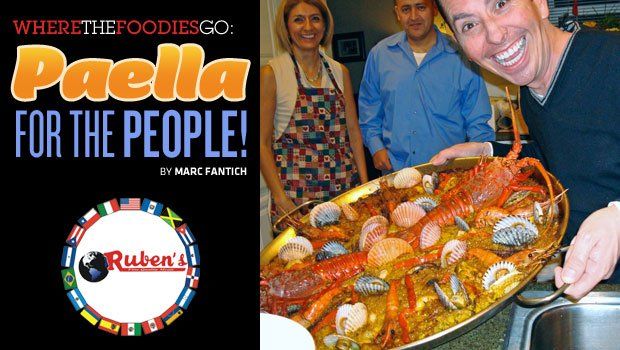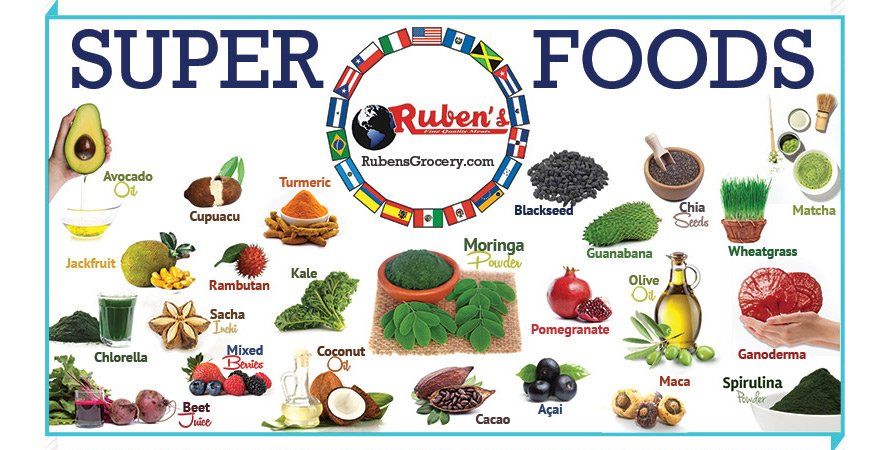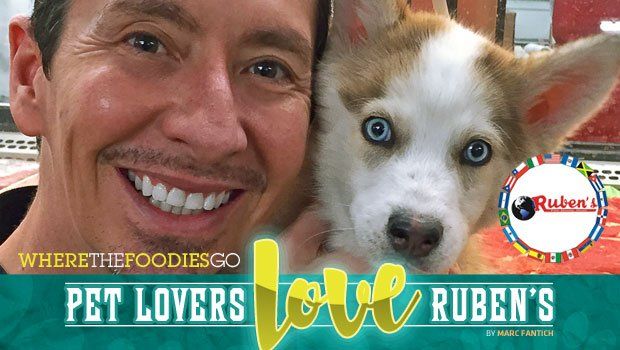Ruben's Paella
February 2, 2015

It’s like the Mustang vs. Camaro wars of 1970. Paella faces the same battle. It all depends on who you ask as to which is the right way to prepare it, and I REALLY want to learn how to make one. Don’t you? Before I call my buddy Ruben at Ruben’s Grocery Store to steal his recipe, I’m going to share my research about the history of Paella. Where dishes come from interest me, so guess what, you’re about to learn something. (The fun part is some of my story is made up, like the dates, because dates bore me. The rest, however, excites me!)
There are three big stories surrounding who created Paella. WIKI says Paella came from the Moores, the French and the Spaniards. I’m buying into the Spaniard’s story… Probably because Mexico’s story wasn’t on WIKI and the Spaniard’s version of it was the easiest for me to understand.
Somewhere back in the 1500s is where the first Paella was traced back. Spanish royalty would have these lavish parties and there were tons of leftovers. The poor people (the people doing the serving) would get to keep these leftovers. They’d split up all the food and take it home to their families. But it was different back then. Villages all shared in these mini feasts and it took huge cooking pans to prepare. They’d add rice and veggies, toss in seasoning and slow cook the Paella until it was ready to be shared by the village. There are 3,000 stories of the origin of the word Paella and here’s the one to memorize: Paella comes from the Spanish word “por ella,” meaning “for her,” and is said to come from the fact that the first Paella was made by a man for his fiancé. Another persuasive story is the word changed a little and was part of some Latin word for BIG OLD PAN… And as Forrest Gump would say, “That’s about all I know about Paella.”
Now pack up, kids! We’re taking a field trip to Ruben’s. I want to make a Paella and he’s the guy with all the answers. Marc: Hey Ruben! What exactly do we need to know before diving in headfirst into making a Paella? Ruben: Well, first you need to know that there are two basic schools of thought on Paella. The first is that Paella should always be authentic and should not be changed from the Spanish versions that are cooked in Valencia, Spain. The second school of thought says Paella should be fun and you should be able to do anything you want with it. To the first school of thought I say: BOOOOOOORING! I am loyal to the second school of thought wholeheartedly. Paella should always be fun to both cook and enjoy. Remember there are just five basic ingredients that all Paellas should have (see chart on middle column.)
In the 20 years I have been selling Paella ingredients I have NEVER come across two people who have ever agreed on what ingredients they use in their Paella. NEVER! I may be a foodie by trade but I’m a mathematician by education and that small statistic is enough to prove to me that there is no right or wrong recipe
for Paella.
Marc: Actually, I love dishes that I can tweak here and there. How can it get any better?
Ruben: Oh it DOES get better!! It is super easy to make. You know how you love to make pizzas, Marc? Think of Paella as Pizza. Once you get the basics down, like the dough and sauce for pizza, the world of possibilities is endless. Well, the same goes for Paella. Once you get the basics of making the stock and the ratios of stock-to-rice, you can make as many different Paellas as your mind can imagine.
First you want to start with the right ingredients:
The best rice to use is a short-to-medium grain rice. Each rice has its own unique taste and textures; medium-grain rice is used in Paella because it can absorb a lot more liquid than other kinds of rice, and therefore it will have a much better flavor. The stock should be flavorful and can be made with either chicken, seafood, vegetables or a combination of all three. I start my stock early in the morning and I let it simmer all day long. But there are many shortcuts to consider, as you could start with store-bought stock as well and then enhance it to your liking.
Fresh proteins are best and these usually consist of chicken, rabbit, pork, Spanish chorizo, or seafood. Ultimately, the protein you choose can really be anything that suits your fancy. Typical vegetables to consider would be fresh tomatoes, green beans, peas, artichokes, peppers, asparagus, and legumes. They can also be frozen! Again, these are all mere suggestions. And your spices should include things like onions, garlic, herbs, paprika, and of course, the ever present azafrán or saffron.
What is saffron or azafrán? Saffron is a wonderfully fragrant spice to use in cooking. It is the stigma of the crocus flower, those little strands that come out of the middle. There is NO measuring of any of these ingredients with the exception of the rice and the stock which is 1 cup rice to 3 cups stock. Everything else is to your fancy, just like salt-and-pepper. There are many videos on YouTube on how to cook Paella, but basically the way it goes is as follows:
Brown your proteins, one at a time, in olive oil in your Paella. Add your garlic and onions and cook those until they are translucent and almost caramelized. Now, introduce your vegetables and brown those until they are at least halfway cooked. At this point add your stock and spices and cook until it all becomes somewhat of a soup. Lastly, add rice and stir until completely mixed. Now just simmer until the rice is cooked “al dente,” which means tender, but not mushy. If the stock runs out before the rice is cooked, simply add a little more water. Once the rice is cooked I like to turn up the flame for about five minutes to get a crust on the bottom, also known as socarrat, & that’s it!
At Ruben’s you will find every single item you’ll need to make your Paella. From the Paella pan, to the burner, to the rice, spices, and all of the ingredients. And for those that can’t even boil an egg, Ruben’s has Paella kits that allow you to cheat and start your Paella with pre-made broth and spiced rice! All you do is add fresh vegetables and seafood, or any other protein, to make it your own. For additional help simply visit Ruben’s and he will personally walk you through the whole process.
Latest News

Webster defines MID LIFE CRISIS as a “period of emotional turmoil caused by the realization that one is no longer young.” This used to be a problem that one handled simply by dropping some Benjamins and buying a brand new canary-yellow Corvette. Problem solved, right? Funny, I was stuck at that same crossroad. Turn right and buy a beautiful sports-car? Turn left and get a beautiful new girlfriend? Or go straight ahead and get the new body I desperately needed so I’d live long enough to enjoy both the new car AND the new girl! I found that I wasn’t alone. Every morning my day starts off with a trip to Ruben’s Grocery Store to visit with the staff, grab my day’s snacks and finally, bend Ruben’s ear a little while. Every now and then I run into him and he’ll be using his Nutri-Bullet to whip up this concoction of all sorts of powders and frozen berries. The World of SuperFoods That’s when it hit me. I have never looked at him that way before but he seemed pretty physically fit. Putting two and two together I asked him a few questions and discovered that he works out every day and makes this shake each morning from these magical powders he carries in the store. They each have a name and purpose, but I simply call them “super- food powders.” The Health-Improving Claims The powders he sells are not the normal protein shake powders all the supplement stores carry; these are the real deal: single ingredient, raw, organic, non-GMO superfoods. Powders that help people put their medicine down and start living normal lives again. Ruben’s carries these superfood powders and his brother, Hugo, has started giving these lectures in the store and people are getting healthy. I watched this a few months as I took the powders, mostly skeptical, but I no longer need my blood pressure medication and all my other health-related problems are gone. Coincidence? Nope, too many people are getting better for it to be a coincidence. The Natural Side of Energy As Ruben puts it: “These superfoods are not miracles, they actually don’t heal anything. What they do is feed your body at a molecular level. Most of us are eating a breakfast full of carbs, like cereal or pancakes or tacos. Or sometimes even worse, not eating breakfast at all. When you make a smoothie from the superfoods that contain very low carbs and lots and lots of great proteins based on non-genetically modified plants, your body responds with incredible energy levels. At the same time, your pH changes from acidic to alkaline; the number one factor in cancer is an acidic body. All of this makes your organs, like your kidneys and liver, function at a much higher level and in turn, your body begins to heal whatever ails you.” Eat. Grow. Shine! Today it’s pretty easy to get the body you have always wanted. You just need a plan and I’ll share mine with you. Believe me, if I can do it, so can you. I dropped 220 lbs. Part of that was my ex-wife! She was 120 lbs. You do the math. I take these superfoods powders each morning now, mixed with a glass of tasty yogurt. That’s it. These superfoods powders appear to be doing great things for people. Set aside a few minutes today and invest 10 minutes in getting some free information about these superfoods at Ruben’s. Tell them Marc sent you.

WOW! Christmas season is already here? Where did the year go? The best part about Christmas for me and all my foodie friends is all the things Ruben’s has planned for us. Like importing in all the breads, pastries, candies and once-a-year things that make your house look, feel and smell like Christmas. Everyone looks forward to Ruben’s Panettones from Italy, Argentina, Brazil, and Peru. The Turrones from Spain, Italy, & Argentina. The German Stollens, along with candy from all over the world, including the traditional Mexican Christmas candies Colaciones! The special way that Ruben’s store is transformed into a special holiday cooking and gift destination. On top of all the exciting products that show up for the holidays, here’s what I look forward to the most. Every year Ruben finds that one special thing, that you can’t find anywhere else, like what he does each year with those giant King Crabs. Ruben seeks on something special each year, and knocks it out of the park! I got a sneak peek and by the time this article gets to you, Ruben will already be stocking this specialty item for you and your family…I promise, this will make Christmas at your house unforgettable. Here it comes! About 10 years ago I found BODIN in Spain, the restaurant that holds the Guinness world record for “THE OLDEST RESTAURANT IN THE WORLD.” What makes BODIN in Madrid so special, besides cooking for people since 1725, NEARLY 300 YEARS?!? It’s their roasted suckling pig dish that’s so tender the waiters cut it with a ceramic plate, as well as the “Jabugo Jamon” from these special pigs that only come from that region. Ibérico pigs are a special breed that, oh hell! It’ll take forever to explain. Suffice it to say, these pigs eat a diet from the area they live which is rich in natural resources, in this case, acorns and berries, adding up to the perfect diet for a pig and making them taste better than any pork you will find on this planet or any other planet for that matter : ) Now here’s what Ruben did. For over 100 years the USDA has banned the import of pork from other countries. They said it was impossible to ensure a healthy produce could stand the trip from there to here, so the USDA forbid it, period. End of story. In fact, try to bring over pork chops from Reynosa. I dare you. The Border Patrol will take your chops, AND YOUR CAR, and slap you with a huge fine. So how was Ruben able to pull this off? Who knows! But he did. ONLY Ruben’s, and only for a limited time. He’s not just bringing that pig FRESH, he’s bringing the suckling babies for roasting in your “Ataud” or your kitchen’s oven. The special baby Ibérico pigs, the babies that have only sipped milk from mamma’s breasts, are here now and available for your family to roast and enjoy. “If you don’t know how to prepare this delicacy, ‘Ibérico Pata Negra Lechon,’ Ruben will teach you how to cook it to perfection or you can ask Chef Larry Delgado, of S A L T New American Table, to prepare it for you along with some paired sides,” says Ruben. He always tries to add one more delightful thing to his holiday lineup and he did it again. Suckling pigs, about eight pounds each and pretty simple to roast. They are here now for you to pick up and prepare for an unforgettable evening.

As a pet lover with a long history of living with cats and dogs I have a pretty strong stance on what I’m about to say. All living creatures deserve “REAL” food. That being said, this installment of “Where the Foodies Go” is dedicated to all of our pets. I’d like you to think about something for a second. Have you been brainwashed by the decades of commercials and the billions of dollars of marketing invested on making you think that what you feed your pets is healthy? (You already know where I’m going with this.) First, the truth about pet food off the shelf, and remember, this article honors what Ruben has going on at his unique store. He sells the same “off the shelf” crappy pet food that every grocery store in America sells and this article will kill those sales. But he opened my eyes to an undeniable truth. That being said, the food in the cans and bags we feed our pets is simply awful. Take a moment and read the label’s ingredients. The commercials you see would have you think your dog is getting a sirloin steak straight from the butcher’s stash of his best steaks. Contrary to what the dog food companies show you on TV commercials, your dog doesn’t get sirloin from a healthy cow who spent its life nibbling on fresh tall grass, nor does he get white chicken breast from a hen who spent its life pecking happily around the sunny barnyard. In fact, meat used in pet food comes from what the pet industry calls the Four Ds. The Four Ds stands for meat from livestock that was either Diseased, Disabled, Dying or Dead when it arrived at the slaughter house. It won’t pass the USDA inspection so in the pet food bin it goes. What goes into the pet food bin is deemed unfit for human consumption because of mold, rancidity, or contaminants – yuck! They boil the poison out of it and pulverize it so it can be mixed with other empty calories and either squirted in a can or dried into nasty little kibbles. I have the answer, but first I need to be sure you buy in to this idea. Dogs have been domesticated for about 15,000 years (that’s amazing, isn’t it?) and up until the 1930s, they were NEVER fed “kibble” or “canned” brands from a store. Dogs were fed real meat and vegetables, and a little homemade bread. On this diet they thrived, frequently living into their late teens. How old was your last pet that passed on? 12? 13? These pet food companies are cutting our pets’ lives by 30%, (and we are allowing them). As humans, we constantly hear about our processed food cutting years off our lives and ruining our quality of life with diabetes, obesity and all kinds of ailments caused from a weakened immune system from all the nasty things they put in our processed food. Here’s my question to you. Totally rhetorical. Would you spend an extra 50 cents a day to assure your child lives to the ripe old age of 90 rather that 55? We have that answer for your children already. Feed them an intelligent diet of fresh fruit, vegetables and smart proteins, right? Well, a few weeks ago I got to sit in on a meeting at Ruben’s where this man came in with a recipe that looked like he was making a nutritious stew for a camping trip. It had wonderful ingredients bought right off the shelves at Ruben’s. Blueberries, fresh kale, whole turkeys straight from the butcher’s block and everything else you’d feed your 5-year-old little girl to ensure a smart and balanced diet. But he knew that he did not want to feed him the aforementioned “crappy pet food,” so he researched what he believed to be the smartest diet for his pet and created a homemade blend of the healthiest ingredients. Already being a Ruben’s customer he knew that those ingredients would be found there. His only dilemma now would be to find the equipment to process the food. To his great surprise and relief, he discovered that Ruben’s has been processing very special pet food for about 5 years now. Ruben’s invites you to stop in and see how simple it is to make a couple weeks of truly nutritional food for your pets. You pick the ingredients and Ruben does the rest. It’s simple and we are all doing it. Is it more expensive? Yes it is, about 20 cents more per meal. Do you have 20 cents today? LIKE Ruben’s on Facebook to keep up with all the interesting things he has going on. Those DEADLIEST CATCH crabs are right around the corner, so you want to be on that list!
